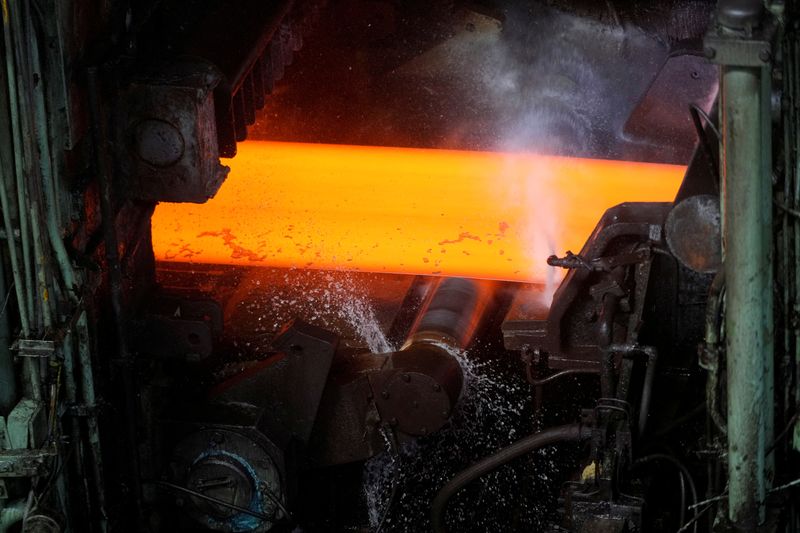By Amy Lv and Tony Munroe
BEIJING/SINGAPORE (Reuters) – U.S. President Joe Biden’s push to triple tariffs on Chinese steel imports deals a mostly symbolic blow to an industry facing heightened concerns over faltering local demand and threats of more backlash stronger against growing Chinese exports.
Steel consumption in the world’s second-largest economy is set to fall again this year as the prolonged housing crisis has yet to find an end and infrastructure demand growth slows after 12 indebted regions were ordered to halt some projects.
The state-backed China Metallurgical Industry Planning and Research Institute (MPI) forecasts a 1.7% drop in Chinese steel demand this year, following a 3.3% decline in 2023.
While China’s steel exports rose by more than a third last year to the highest level since 2016 at 90.26 million tonnes, about 9% of total crude steel production, only 598,000 tonnes of shipments went to China. United States. This is an 8.2% decline from volumes shipped to the United States the previous year and less than 1% of China’s total steel exports worth $85 billion in 2023.
China, the world’s largest steel producer and exporter, is only the seventh largest shipper of steel to the United States, softening the blow of Biden’s proposal to raise tariffs imposed by his predecessor Donald Trump on some steel products to 25%. steel and aluminium.
“We don’t think there will be a big impact as the main destinations for China’s steel exports are Japan, South Korea and Middle Eastern countries,” said an analyst at a China-based steel trader, who preferred to remain anonymous because he was not named. authorized to speak to the media.
Boosted by low local prices, Chinese steel producers and traders are on track to match or exceed last year’s exports, with domestic information provider Lange Steel raising its forecast to more than 100 million tonnes for 2024 after March shipments exceeded expectations.
China’s cheap steel products are also fueling complaints outside the United States.
Late last year, India imposed anti-dumping duties on some Chinese steel imports, while Mexico announced a tariff of nearly 80%. Thailand has launched an investigation into Chinese rolled steel imports and Brazilian steelmakers are urging the government to impose a 25% tariff on imports.
A report by a Chinese state research agency identified a total of 112 declarations by countries regarding anti-dumping and anti-subsidy measures on Chinese steel products in 2023, an increase of about 20 compared to 2022.
“We expect more trade friction this year,” said David Cachot, research director at consultancy Wood Mackenzie.
NATIONAL DEPRESSION
Beijing’s latest support for the sector, a plan to support equipment upgrades in the industrial and agricultural sectors and speed up consumer replacement of cars and appliances, is unlikely to fully offset reduced steel consumption in the real estate sector.
The CRU consultancy group predicts that an additional 8-9 million tonnes of steel demand will be created over the next four years thanks to this policy. By comparison, the state metallurgical institute expects construction demand to fall by 20 million tons, or 4 percent, this year.
Some analysts said they expect infrastructure steel consumption to grow by only 1% to 2% this year, compared with previous expectations of 7% to 8%, after Beijing’s demand for a dozen Regional governments delaying or halting some state-funded infrastructure projects has prompted other regions to follow suit.
In recent years, Beijing has imposed curbs on steel production to both reduce supply and curb carbon emissions, and observers and industry insiders say further production cuts are needed to reduce excess capacity.
“The steel industry is facing a glaring contradiction: strong supply capacity and declining demand,” Luo Tiejun, vice president of the state-backed China Iron and Steel Association (CISA), said at an industry event this week in southern China.
“The key to addressing this problem is for major manufacturers to take the lead in curbing the production pace based on demand,” Luo said, according to the group’s WeChat account.
EXPORTS IN RESCUE?
In March, China’s steel exports rose to 9.89 million tonnes, the highest level in a month since July 2016, bringing the first-quarter total to 25.8 million, even as overall exports in the world’s second-largest economy have undergone a sharp contraction.
Worth $20.3 billion, China’s steel exports in the first quarter averaged $789 per ton, far above local prices which averaged 4,145 yuan ($572.30). , as data from Mysteel, a consultancy and customs company, shows.
A weaker yuan against the U.S. dollar, partly due to delays in the Federal Reserve’s interest rate cuts, is also expected to ease steel exports.
But exports are sensitive to uncertainty arising not only from trade frictions, but also from growing foreign supply and the possibility of Beijing imposing limits on production.
To be sure, global steel demand is expected to rise 1.7% to 1.793 billion tonnes this year, the World Steel Association said.

“Although some countries are building their own capacity to meet increased local demand, this cannot meet demand quickly enough, which means there is still room for steel from China,” said Kevin Bai , an analyst at CRU Group based in Beijing. .
($1 = 7.2426 yuan)